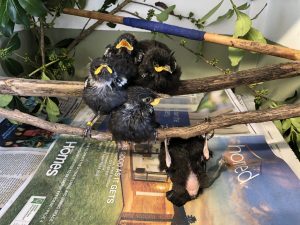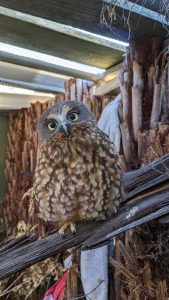
Baby tūī in nursery care - some still learning how to perch! Many of these birds were victims of cat attacks. Photo by MR
A day in the nursery goes a little something like this: arrive at 6.30-7.00am. Warm up syringe feeding mixes for each species in care. Feed the babies. Administer medications. Feed the babies. Clean out housing. Feed the babies. Set up housing with fresh branches and appropriate food. Feed the babies. Administer fluid therapy. Feed the babies. Prep syringe food mixes for the next day. Feed the babies. Restock supplies. Feed the babies. Clean out housing again. Feed the babies. Administer medications. Feed the babies. Feed the babies. Feed the babies.
The day ends between 7.00-9.00pm, depending on the needs of the birds in care. Birds may be fed as frequently as every 10 minutes! It’s a long day, and the babies never stop crying – but it’s all worth it to watch them grow into healthy young adults.
The 2021-2022 baby bird season has been our busiest yet. Our native nursery saw the likes of tūī, tauhou (silvereye), kōtare (kingfisher), ruru, mioweka/konini/moho pererū (banded rail), warou (welcome swallow), pūkeko, spur-winged plover, matuku moana (white-faced heron), and poaka (pied stilt). Our non-native nursery cared for blackbirds, song thrush, starlings, finches, sparrows, quails, pheasants, doves, pigeons, and ducklings, among others.
2020-2021 was a ruru season, but this season has been dominated by especially high numbers of kōtare and matuku moana. These past few months, we have released 24 young sacred kingfishers, and we have another 26 still in care. Most of these were raised from nestlings, and many arrived underweight and weak. We are proud to have successfully released nine young herons, most of whom arrived as sad, spiky little balls. In the wild, matuku moana lay up to five eggs, but the weaker birds are kicked out of the nest by their siblings. You can guess which nestlings we typically receive! These little ones needed high levels of care in their first weeks of life.

Juvenile matuku moana (white-faced herons) in their nursery enclosure. Photo by MR
Thanks to your support, we have raised three hatchling banded rails, two of which arrived in very unstable condition. We have released more than 65 young tūī this season, with 12 awaiting release. We have released around 90 sparrows and more than 100 blackbirds, with more soon to join them. We have released 18 pūkeko so far, and are still caring for a further 11. Around 40 tauhou have spread their wings, and 11 more are soon to be released.*
While the species we admit vary slightly from year to year, the main reasons for admission remain the same: cat interaction and well-intentioned bird-napping.
Baby birds are highly vulnerable to predation from introduced mammals, particularly cats. While all birds are at risk, naive fledglings are most impacted. We received over 350 confirmed cat attack victims in the first 2.5 months of 2022 alone, and over 1,650 in 2021. This does not include the countless other birds who were suspected but unconfirmed cat attack victims. Sadly, the mortality rate is extremely high in these cases. Common injuries resulting from cat attacks include: ruptured airsacs (which produces air bubbles underneath the skin), cuts and puncture wounds, fractured bones, ruptured internal organs, and internal bleeding. The bacteria in a cat’s mouth creates a high risk of deadly infection in any birds with even minor wounds (which may not be visible). Unfortunately, many of these birds arrive with such severe injuries that they need to be humanely euthanised in our triage clinic.

A baby ruru in nursery care. Photo by MR
This baby season, our confirmed cat attack victims included almost 40 tūī, 23 kōtare, 96 tauhou, approximately 350 blackbirds, approximately 115 song thrush, and approximately 220 sparrows. This does not include the many other young birds who were presumed victims. Sadly, the majority of these birds arrived too badly injured to rehabilitate.
You can help baby birds by keeping cats at home or under supervision. This is a vulnerable time for fledgling birds as they are taking their first steps into the big wide world, and can be quite oblivious to danger. If any cat interaction occurs, the bird needs to be taken to a rehabilitator as soon as possible to start antibiotic treatment. Please tell us if the bird you are bringing in has experienced cat interaction – we need to know, so that we can provide the correct treatment.
The second most common reason for admission is bird-napping. Fledgling birds leave the nest before they are able to fly properly, and can be found hopping around on the ground. Parent birds will come by with food, but will likely not be around all the time. This is totally normal! The best place for a healthy baby bird is with their parents. They may appear awkward but they are just learning about the world around them. We often receive young birds who have been mistakenly taken from their parents – please don’t take it personally if we ask you to return them! We appreciate your efforts to keep them safe, and we are always more than happy to give advice to protect the little ones in their natural environment.

A ruru raised in the nursery spending time in the aviary before release. Photo by F. Chaplin
As always, we finish the season with a list of winter jobs, topics to research, and improvements to make for next season. We constantly strive to improve our knowledge and care for our babies. We are currently planning:
- Our own 100% insect flour blend to replace commercial insectivore powders (some species thrive on the commercial blend, but others seem to do better on cricket and mealworm flours). We use this as a base for many syringe feeding recipes for our babies.
- A better, more productive bug farm (we hope to spend the winter growing mealworms to stockpile).
- A baby diet book including recipes for syringe feeding and foods to offer. We currently have an adult bird book but the baby book is still in draft format!
- Improvements to the outdoor aviaries, including fully mosquito proofing any that aren’t already. This protects our babies against mosquito-borne diseases such as avian malaria.
- More educational information to try and prevent harm before it happens! (Let us know if there are any topics you would like us to cover.)
We are endlessly grateful for your support, and we are never more appreciative than during baby bird season! Thanks to you, we’ve been able to rehabilitate hundreds of baby birds and return them to the wild. If you would like to help us help more birds, please visit our donate page.
*All numbers are accurate as of late March 2022